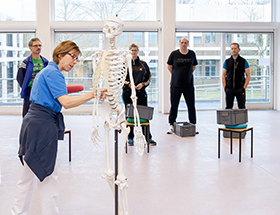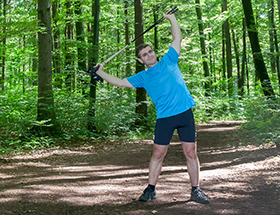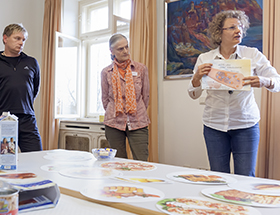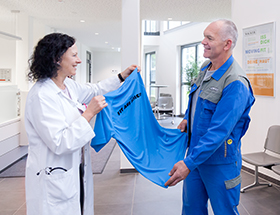Ready for the Shift
In the summer of 2013, WACKER began working with the German statutory pension insurance system on a pilot project that would give a fresh new face to health care for shift workers.
Even though shift workers at WACKER are actually used to strenuous physical work, most of them still break into quite a sweat during Nordic walking sessions at Lake Starnberg (south of Munich). The activity scheduled for the first day of Fit for Your Shift is no casual stroll – all ten participants instead march briskly down a small country lane. Even experienced speed walkers like Günther Zechmeister are enthusiastic: “The day outdoors was really interesting,” says the machine operator afterwards. “I learned some new power-walking steps. I hadn’t necessarily expected that.”
Nine times each year, up to 15 employees have an opportunity to join the program.
Fit for Your Shift is a preventive health-care project for WACKER shift workers. Nine times each year, up to 15 employees have an opportunity to join the program, which consists of a total of four phases. Phase 1 – the clinic-based phase – is held at a clinic on Lake Starnberg and lasts five days. Here participants first undergo a general physical, after which they attend seminars and training sessions to acquire simple, practical tools for maintaining and improving their health.
Back-Friendly Lifting
For Annett Pleil, for instance, the back-health training on the second and third days was particularly important. “I work in Polysilicon Cleaning,” she explained, “and part of my job involves lifting ten-kilogram bags into a cardboard box. Over the long run, this begins to affect my neck and back.” The 45-year-old is hoping that the session in Höhenried Clinic will provide her with tips on how to strengthen her muscles and how to lift items without straining her back.
Back-health training begins with a walking exercise where everyone carries around a gray plastic crate with sandbags in it. The facilitator explains the best way to lift the crates: “Keep the soles of your feet on the ground, keep your back straight, tip your pelvis and keep the load centered.” It helps to picture the pelvis as a bowl of water – the water should spill out of the bowl when you lift. When walking, on the other hand, participants should imagine that they had just won a gold medal, striding through the gymnasium with their chests swelled with pride.
“Keep the soles of your feet on the ground, keep your back straight, tip your pelvis and keep the load centered.”
The facilitator explains the best way to lift the crates.
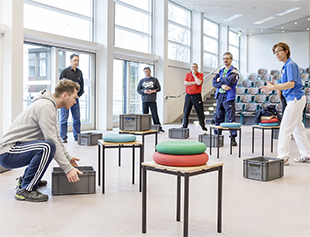
Pleil feels that handy little tips like these are easy to implement on the job. Even more important for her, however, is that her time spent at Lake Starnberg is just the beginning. The clinic-based phase, after all, is followed by the practical phase: for 12 weeks, participants meet with a trainer from the SV Wacker sports association to undergo regular strength and endurance training for their backs. They also practice relaxation techniques and learn about proper nutrition. After these 12 weeks, participants move on to Phase 3, where they participate in a self-directed course of their own choosing. “SV Wacker fortunately has a lot of good options,” says Pleil, who already knows what she wants to focus on during the self-guided phase: “I want to do Tae Bo, a form of kick-boxing from Thailand,” she says. “And do back workouts of course.”
Long-Term Improvements
Over 200 alternating-shift workers from Burghausen have taken part in Fit for Your Shift since the program began in the summer of 2013. “We don’t know exactly why, but nearly everyone who participates is much more relaxed at work afterwards,” says Dr. Ursula Bailer, one of WACKER’s company physicians. “Losing weight and quitting smoking aren’t goals of the program – but a lot of participants do just that. Two-thirds of them make long-term lifestyle changes, exercising more, eating more healthily and coping with stress better.”
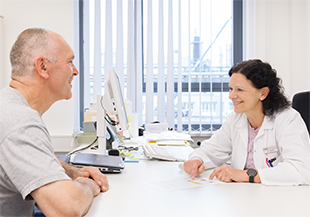
“Two-thirds of them make long-term lifestyle changes.”
Dr. Ursula Bailer discusses the results of Bernhard Rothenaicher’s new lifestyle with him. The machine operator lost a considerable amount of weight and his blood pressure decreased.
Bernhard Rothenaicher is a machine operator who was among the first to participate in Fit for Your Shift. At first, he laughed at the recommendation to pay attention to the ingredients in food. “Now I take a good look at what’s in it,” he says. “That advice in particular has really paid off for me.” Rothenaicher, who is 1.79 meters tall and weighed 104 kilograms when the program began, set himself a weight target of 95 kilos. But after one year, when he finished a two-day, Phase 4 refresher course in Höhenried Clinic, his weight was down to just 92 kilos – and his blood pressure had dropped considerably.
His recipe for success? After Phase 1, Rothenaicher started out by finally using his cross-trainer, which had sat unused at his home for some time. He followed this with strength training and jogging. Four months after the program started in Höhenried, the 50-year-old overhauled his diet. “I cut out the two bologna sandwiches I used to eat on the early shift,” he recalls, “and now I take a salad or fruit with low-fat yogurt with me to work. I avoid soft drinks now, and I’ve gone over to alcohol-free beer.”
For Rothenaicher, shedding pounds was not the only outcome – a family effect came into play as well, something Dr. Bailer has seen many times: “Spouses join in too – and everyone’s happy.” In Rothenaicher’s case, the entire family got involved. “My wife, both of my grown-up children and I lost a total of 50 kilos,” he notes with visible pride. And last year, he completed a half-marathon for the first time in his life – for now without his wife and children.
Pizza Versus Spaghetti
Back to Höhenried: the third day involves water aerobics and back-health training, followed by a nutrition seminar. Nutrition scientist Kathrin Karau sets a table with pizza, French fries and fried “currywurst” sausage – life-sized photos of the dishes, at any rate. “Yum,” someone says and turns over the first photo. On the back of the photo is a listing of the fat and calories that a pepperoni pizza like this has – which makes it less appetizing.
Participants then put the photos together to make menus, and here’s what they learned: spaghetti with bolognese sauce and a salad is just as filling as the pizza, but contains only 30 percent of the fat. For Günther Zechmeister, the experienced power walker, this is not news. The machine operator from Functional Silicones and Silicone Fluids has been a vegetarian for years and is very active – in addition to Nordic walking, he is especially fond of cycling and strength training. “I’m in good shape,” he says, “but I’d like to get in even better shape. And the 36-year-old does, in fact, learn a few things this afternoon that he hadn’t known before. On the night shift, for example, hot soup or a vegetable stew is the ideal thing to eat at about 4 in the morning, because the body’s temperature decreases at that time, making a hot meal especially beneficial.
“The days in Höhenried really made a difference.”
Günther Zechmeister
Machine operator, Fit for Your Shift participant
At the end of the week, Zechmeister takes home something from nearly every area: new steps from the health seminar, a few tasty recipes from the nutrition seminar, and some simple relaxation exercises from the health seminar to help him fall asleep. He also realized something: “The days in Höhenried really made a difference.” At lunch on the last day, it occurs to him that, unlike at the beginning of the program, all of the light dishes containing lots of vegetables now run out quickly.
Dr. Bailer mentors and supports Fit for Your Shift participants throughout the year. “Their overall health has improved significantly,” she says. “By the end of the project, you can tell both by their lab results and by their survey responses. Not everything goes away, but everything gets better.”
Previous participants spread the word about their experiences with so much enthusiasm that sooner or later, not only have their families joined in, many of their colleagues have too – now when they talk about what they’ve achieved, their coworkers listen attentively. Plus, you can tell they’ve changed their habits just by looking at them.

